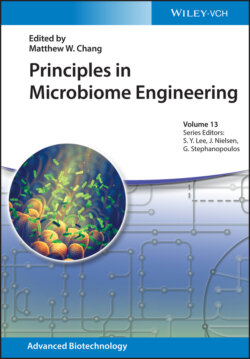Читать книгу Principles in Microbiome Engineering - Группа авторов - Страница 15
1.1.1.2 Gastrointestinal Microbiome
ОглавлениеComparing the various human microbiomes, the gut microbiota constitutes the majority of the microbes in the human body, while presenting the most complex diversity and dynamics between individual members of the microbiota community. The microbiota niches span across the gastrointestinal (GI) tract, where each region (stomach, duodenum, jejunum, ileum, large intestine, and rectal regions) has large environmental variations (pH, soluble oxygen, nutrient, bile salts, and so forth) that promotes the diversity resulting in selective pressure to shape the microbiome. The gut microbiome development can be traced to pre‐natal gestation, where the microbes found in the placenta show similar profiling to the maternal microbiome [17]. Post‐delivery, the gut microbiome is initially shaped by the microbes that are introduced via the oral cavity for the first three years of age. After the individuals, the digestive system is fully developed, the microbiome shifts into the stable phase [14, 15]. Despite extensive efforts to map the gastrointestinal microbiota, the process of classifying the intestinal microbiome is far from complete.
Gastric microbiota is generally known to be acid‐tolerant, where these microbes need to survive under low pH conditions (pH 1–5). In a healthy individual, metagenomic analysis of the gastric microbiota showed an average abundance of Firmicutes (29.6%), Bacteroidetes (46.8%), Actinobacteria (11%), and Proteobacteria (10%). Among these phyla, the predominant genus includes those from the acid‐tolerant Streptococci, Lactobacilli, Staphylococci, and Neisseria spp. [18, 19] Dysbiosis resulting from Helicobacter pylori infection showed a massive shift of Proteobacteria abundance accounting for 93–97% of the total microbiota count [19]. The pathogen H. pylori preferentially localize at the upper gastric mucosa perturbing the gastric microbiota by reducing the microbial diversity and is linked to medical problems such as gastritis, peptic ulcers, and cancer [20].
The small intestine involved in nutrient absorption with a long, narrow, folded tube structure exhibits restricted nutrient accessibility to promote microbial growth. The primary composition of the small intestinal microbiota is from the Clostridium, Enterococcus, Oxalobacter, Streptococcus, and Veillonella genera. Despite the poor diversity, the microbiota composition fluctuates depending on the structure and the exposure to the digested chyme in the small intestine [21]. Most of the microbes colonizing the small intestine carry genes encoding for carbohydrate phosphotransferase that play a role in competitive carbohydrate uptake in the microbiome [22]. Dysbiosis in the small intestinal tract showing increased abundance of Bacteroides spp., Clostridium leptum, and Staphylococcus spp. is linked to pediatric celiac disease [23], while the increased abundance of Escherichia coli and Roseburia spp. is often observed in patients with ileal Crohn's disease [24].
The large intestine (including the cecum, colon, and rectum) has the highest microbiota density in the whole body with approximately 1012 cells per gram, weighing about 1.5 kg in an average adult. The colorectal microbiota is dominated by phyla Firmicutes and Bacteroidetes that account for more than 80% of the total microbial population in adults [25, 26]. Studies have shown that certain predominant species in the gut populate the colorectal region based on the presence of dietary nutrients. Bacteroides were found to be enriched in a carbohydrate‐rich diet, while dietary mucin and complex sugars encourage the abundance of Prevotella and Ruminococcus, respectively [27].
